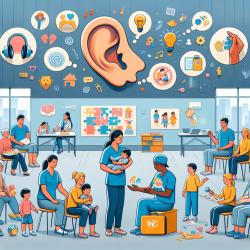In the realm of pediatric therapy, staying abreast of the latest research is crucial for practitioners committed to improving outcomes for children. One recent study that holds significant implications for speech-language pathologists and other rehabilitation professionals is titled "Functioning and Disability Profile of Children with Microcephaly Associated with Congenital Zika Virus Infection" (Ferreira et al., 2018). This research, published in the International Journal of Environmental Research and Public Health, offers valuable insights into the multifaceted challenges faced by children with Zika virus-related microcephaly and underscores the importance of the International Classification of Functioning, Disability, and Health (ICF) framework in guiding therapeutic interventions.
The study provides a comprehensive profile of the functional and disability aspects of children with microcephaly linked to Zika virus infection, using the ICF core sets for cerebral palsy. The findings are both illuminating and actionable for practitioners who aim to enhance their clinical practice through data-driven decisions.
Key Findings from the Study
- Complete Disability in Body Functions: The study revealed that most children exhibited complete disability in key body function categories, particularly mental functions of language and intellectual functions. This highlights the need for targeted interventions in communication and cognitive development.
- Severe Impact on Mobility: Mobility-related activities and participation were highly impacted, with 94.1% of the children unable to perform age-appropriate fine motor hand movements and 70.6% unable to walk. This underscores the necessity for early and intensive physical therapy and assistive technology.
- Environmental Factors: Immediate family, friends, and health services were identified as complete facilitators, whereas societal attitudes were seen as significant barriers. This indicates the importance of a supportive social network and the need for public awareness campaigns to reduce stigma.
Implications for Practice
For speech-language pathologists and other rehabilitation professionals, integrating the ICF framework into clinical practice can provide a holistic approach to assessing and addressing the needs of children with Zika virus-related microcephaly. Here are some actionable steps based on the study's findings:
- Utilize ICF Core Sets: Incorporate the ICF core sets for cerebral palsy in assessments to capture a comprehensive profile of each child's functional abilities and limitations.
- Multidisciplinary Approach: Collaborate with other healthcare professionals, including physical therapists and occupational therapists, to develop a cohesive intervention plan that addresses both physical and cognitive needs.
- Family-Centered Care: Engage families as active participants in the therapeutic process, recognizing their role as primary facilitators and ensuring that interventions align with family priorities and goals.
- Advocate for Supportive Policies: Work with local health services and policymakers to ensure that children have access to necessary resources, including assistive technologies and specialized care.
By leveraging the insights from this study and implementing the ICF framework, practitioners can make informed, data-driven decisions that significantly enhance the quality of care for children with Zika virus-related microcephaly.
To read the original research paper, please follow this link: Functioning and Disability Profile of Children with Microcephaly Associated with Congenital Zika Virus Infection.










